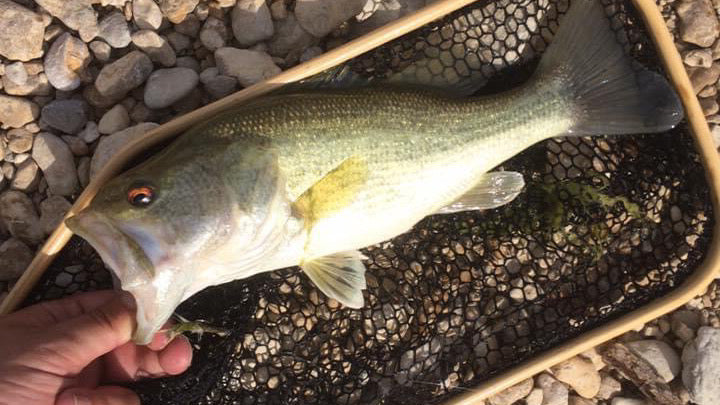
Just Something About Fishing (part three)
Share
For the next few years, I would continue my Sunday quest, and as I became more talented in the industrial plumbing world, the more pressure was being placed upon my shoulders. Soon Sunday afternoons and evenings were the only time I had for myself. If the weather was decent, I would set up my fishing rig and head somewhere close by and spend some time on a river or a creek just trying to reset. I became more of a fair-weather fisherman, and my pursuit of the sound of a ripple began to fade.
In the winter of 2007, I chose to walk a different path and joined the United States Army. So what I didn't give away, I put into storage, packed one little handbag, hopped in a cab, and headed to my recruiter. The Recruiters would take me to the Military Entrance Processing Station, or MEPS, in Dallas, for shipment to Fort Benning, Georgia. For the next sixteen weeks, I would train as an infantry mortarman before being sent to my first duty station. In just sixteen weeks, the Drill Sergeants were able to turn a 27-year-old man into a newborn soldier. The transformation that takes place in such a short time is truly remarkable. Though, with 231 years of experience by the time of my acceptance into the Infantry, I suppose they had it pretty well figured out how to turn a soft-skinned civilian into an armed warrior.
In the summer, I arrived at Fort Drum, New York, home of the 10th Mountain Division. I would spend the next few years there, but unfortunately, between training and deployments, there weren't many opportunities for fishing, which was indeed a shame because Fort Drum is very well known for its outdoor activities. The next eight years would be much the same. Between changing duty stations, deployments, military schools, and my most fun thing, training cadets at West Point, I didn't have a lot of time left to pursue fishing. Weekends were ordinarily free, but the incredible hardships a soldier must survive to become prepared for war; also comes with great brothers in burden. It is my firm belief there is no greater bond than the bond forged in suffering, and the greater suffrage shared, the better the bond. So my weekends were spent gallivanting around the towns.
A new fascination had piqued my interest while in the army, the art of Fly Tying. In the military, much of my downtime had been spent on YouTube watching videos about fly casting, different places to fly fish, and videos of people catching giant fish. As anyone who has done any amount of YouTube surfing knows, YouTube will lure you into Alice's Rabbit hole, using your searches and views to keep you entranced like a snake charmer's flute. While captured in one of these spells, I stumbled upon fly tying. I had known about the craft before but had never really given it much thought due to the task's perceived difficulty and the lack of mentors. However, with the invention of YouTube, it became quite clear it wasn't complicated at all. The more videos I watched, the more convinced I became, this would be the next endeavor in my fishing journey. Even when I wasn't watching videos, I was dreaming about the different flies I would tie and the white wales I would catch because of my not yet demonstrated talent.
At the end of eight years, I decided to say farewell to the army and head back to Texas. Now in my mid-thirties, the memory of time spent on the water, the sound of the cast, and the feel of the hook set, filled my dreams. Of course, the fish soon to be caught on my newfound skill, I still hadn't begun to learn, often kept my mind racing, preventing me from dreaming.
Not a month after my return to Texas, I received my first fly tying kit. For a hundred dollars, a vice for holding the bare hook, an assortment of different type hooks, a decent array of fly tying materials like dear hair, several different types of feathers, and about five or six thread spools came in the mail. Also included was a nice little DVD that showed the basics of getting started. How to use the different tools, like the whip finisher, and how to tie the basic fly patterns like a wooly booger, mayflies, or nymphs.
Without hesitation, I set my station up, poured a glass of whiskey, and set out to learn this fantastic skill. A week later, I finally crafted a fly that didn't have glue or material blocking the eyelet, looked close to what I wanted it to, and thought it was fishable. By the end of two weeks, I had the hang of it and had a good variety of flies going. I hadn't ventured off into my own creations, though; I was merely replicating that which I could find on YouTube.

Sometimes I would get lucky and hook into a little bass, but mostly, I was catching BlueGill, Perch, or Panfish. Even this was enjoyable on a fly rod due to its light structure, and again I was just happy to be out on the water, attempting to put the trials of the military in the past. After a few months, I now had a pretty good grasp of fly pattern construction and began toying with my own creations. I would come up with an idea, think about it most of the day while at work, then when I got home, I would sit down at my fly tying desk, pour a drink to get the creative juices flowing, and set to figuring out how to construct the image I had in my mind. The first thing I tied was a large winged black ant pattern because they are often seen flying around Texas at certain times of the year. Next was a small BlueGill pattern, a favorite food of larger fish like Bass. The first attempt of these didn't turn out so great, but after a few days or a week of fiddling, I finally produced a couple I thought a bass might like. I headed to a few familiar streams, and sure enough, I was successful and caught my first few fish on my personally designed pattern, still mostly large BlueGill, large Panfish, and even a Catfish, to my surprise. Still no large Black-Bass, though.

However, I had hope that I was on the right track; I just had to find a sound hole and have the right fly on hand. With this in mind, I began to craft artificial bait that mimicked the insects I frequently saw filling the sky, and around river banks during the different seasons. One night while sitting next to the pool outside my apartment, I saw a slew of what I only know as Texas Dragonflies. Large prehistoric-looking things with two sets of wings, a large head filled with eyes, and a body about an inch or so long. I jumped up, went to my desk, and began construction. It took two or three days, but I finally got it. Like the others, the pattern proved successful with the common fish found in the Texas waters, but it also produced more Largemouth bass catches as well. So it became a pattern I continued to refine.

My time away had caused me to regress to the state of pursuing the catch and not paying as much attention to the beauty around me. I do remember a few fleeting moments, generally at sunset; I would remember to take a look around and just breathe. Usually, that was about when my phone would vibrate, and I would be called to a social gathering of some sort, or a member of my family would need help with something. After all, I was still a plumber, but now, thanks to my time in the military, I was also a general problem solver. Of course, I would stop what I was doing to render any aid that I could. Also while away, somehow, I had forgotten that there was more to life than work, and that something about fishing I learned to love, I could no longer see.
To Be Concluded...


